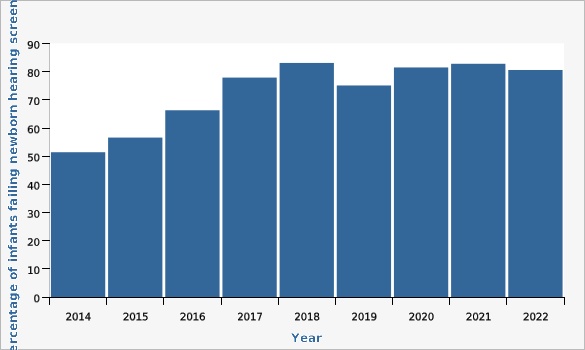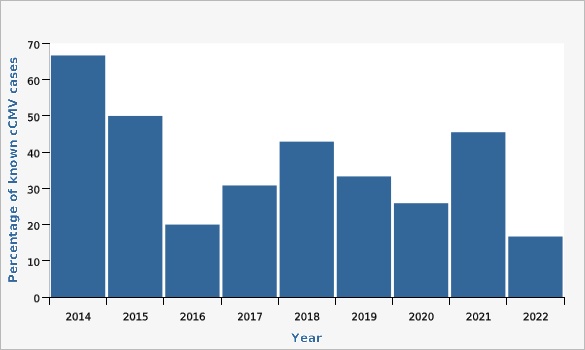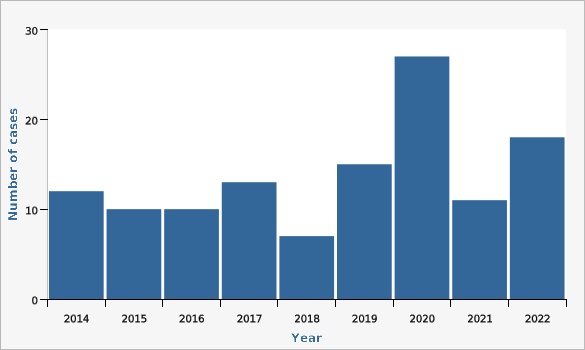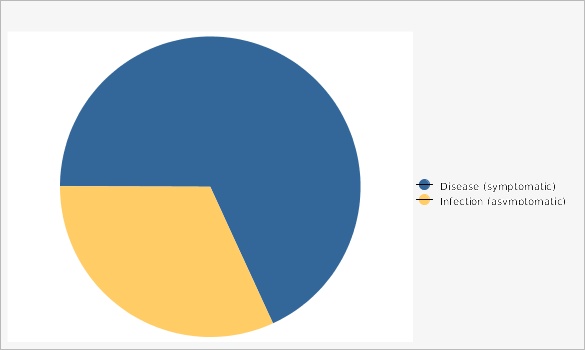Complete Health Indicator Report of Congenital Cytomegalovirus Infection and Hearing Loss
Definition
Cytomegalovirus, or CMV, is the most common infectious cause of birth defects in the United States. Infants with congenital CMV (cCMV) infection can potentially be born with, or develop, progressive long-term health problems, such as cognitive impairment or sensorineural hearing loss. Hearing loss may progress from normal or mild to profound and/or unilateral to bilateral during the first few years of life, which is a critical period for language learning. Hearing loss can affect a child's ability to develop communication, language, social, and academic skills. Testing infants before 21 days of life for cCMV after failing the newborn hearing screening(s) has been mandated in Utah since July 2013. Newborns failing both the first (usually inpatient) and second (usually outpatient) hearing screenings, or those failing just one hearing screening if they are over 14 days old, must be tested. In 2023, the Council of State and Territorial Epidemiologists (CSTE) published standardized case definitions for public health surveillance of cCMV infection and disease. The Utah Department of Health and Human Services CMV program co-authored these definitions along with a team of national CMV experts.Numerator
1.1 Total number of infants receiving CMV testing after failing the newborn hearing screening 1.2 Total cases of cCMV disease identified due to failing the newborn hearing screening 1.3 Total number of cCMV cases 1.4 Total number of cCMV cases classified as "infection" or "disease"Denominator
1.1 Total number of infants failing the newborn hearing screening 1.2 Total number of cCMV cases 1.3 N/A 1.4 Total number of cCMV casesWhy Is This Important?
In the US, approximately 1 in 200 babies is born with congenital CMV infection. One in every 5 of these children will present with clinical signs of cCMV disease, which can include long term developmental disabilities and sensorineural hearing loss (SNHL). Congenital CMV infection is responsible for an estimated 25% of SNHL in children. CMV testing is completed on urine or saliva samples and is time-sensitive. Specimens must be collected before the baby is 21 days old to be accurate for the detection of congenital CMV infection. This is because the incubation period for CMV acquired during or after birth is 21 days. Hence, a positive test with a sample taken after 21 days of age cannot differentiate between an acquired and congenital infection.How Are We Doing?
The Utah Early Hearing Detection and Intervention (EHDI) Program within the Division of Family Health at the Utah Department of Health and Human Services oversees the Cytomegalovirus Public Health Initiative in Utah. The percentage of eligible babies receiving CMV testing has steadily increased from 51% in 2014 to over 80% in 2022.How Do We Compare With the U.S.?
Utah was the first state in the US to conduct standardized cCMV surveillance and to mandate CMV testing after failing the newborn hearing screening in 2013. Since then, several other states have passed similar legislation. In 2019, many Utah birthing hospitals adopted a high-risk testing protocol for cCMV, greatly expanding the number of infants tested for CMV in the state. As of 2023, only one state conducts universal screening for cCMV (Minnesota), and the majority of states do not yet conduct any formal public health surveillance for cCMV.What Is Being Done?
H.B. 81 (2013 General Session) UCA 26-10-10 (re-coded as 26B-7-105 in 2023), whose Chief Sponsor was Representative Ronda Rudd Menlove, went into effect on July 1, 2013. This law directs medical practitioners to test infants who fail the newborn hearing screening for congenital CMV. In 2022, Utah was 1 of 5 states added to the CDC's Surveillance for Emerging Threats to Pregnant Persons and Infants Network's (SETNET) cCMV surveillance pilot project. In 2023, members of Utah's EHDI team authored a position statement establishing a standardized case definition for cCMV infection and disease. It was published by the Council of State and Territorial Epidemiologists (CSTE).Available Services
Information on CMV and the Utah CMV program can be found at [https://familyhealth.utah.gov/cshcn/cmv/]. Primary Children's Hospital has a multi-disciplinary cCMV Clinic that is staffed by cCMV specialists. To schedule an appointment or to consult with the clinic lead, call (801) 662-1705.Health Program Information
Additional information on CMV and the Utah CMV Program can be found at [https://familyhealth.utah.gov/cshcn/cmv/]. Questions can be emailed to cmv@utah.gov.Related Indicators
Related Relevant Population Characteristics Indicators:
Graphical Data Views
CMV 1.1 Percentage of Utah-born infants receiving CMV testing after failing the newborn hearing screening 2014-2022

| Year | Percentage of infants failing newborn hearing screening | |||||
|---|---|---|---|---|---|---|
Record Count: 9 | ||||||
| 2014 | 51.4% | |||||
| 2015 | 56.6% | |||||
| 2016 | 66.3% | |||||
| 2017 | 77.9% | |||||
| 2018 | 83.1% | |||||
| 2019 | 75.1% | |||||
| 2020 | 81.5% | |||||
| 2021 | 82.8% | |||||
| 2022 | 80.6% | |||||
Data Notes
The data comprises in-hospital and out-of-hospital births. Failing the newborn hearing screening for the purposes of prompting CMV testing per Utah code 26B-7-105/rule 398-4 is defined as failing two newborn hearing screenings (inpatient and outpatient) or when a baby is screened for the first time at 14 days of age or older and fails.Data Sources
- NBHS - HI*TRACK Hearing Screening Tracking and Data Management (C) HI*TRACK, Utah State University
- Utah Department of Health and Human Services
CMV 1.2 Percentage of known cCMV cases that were identified in Utah due to failed newborn hearing screening 2014-2022

| Year | Percentage of known cCMV cases | |||||
|---|---|---|---|---|---|---|
Record Count: 9 | ||||||
| 2014 | 66.7% | |||||
| 2015 | 50.0% | |||||
| 2016 | 20.0% | |||||
| 2017 | 30.8% | |||||
| 2018 | 42.9% | |||||
| 2019 | 33.3% | |||||
| 2020 | 25.9% | |||||
| 2021 | 45.5% | |||||
| 2022 | 16.7% | |||||
Data Notes
The data comprises in-hospital and out-of-hospital births. Failing the newborn hearing screening for the purposes of prompting CMV testing per Utah code 26B-7-105/rule 398-4 is defined as failing two newborn hearing screenings (inpatient and outpatient) or when a baby is screened for the first time at 14 days of age or older and fails.Data Sources
- NBHS - HI*TRACK Hearing Screening Tracking and Data Management (C) HI*TRACK, Utah State University
- Utah Department of Health and Human Services
CMV 1.3 Known Utah congenital CMV cases by birth year 2014-2022

| Year | Number of cases | |||||
|---|---|---|---|---|---|---|
Record Count: 9 | ||||||
| 2014 | 12 | |||||
| 2015 | 10 | |||||
| 2016 | 10 | |||||
| 2017 | 13 | |||||
| 2018 | 7 | |||||
| 2019 | 15 | |||||
| 2020 | 27 | |||||
| 2021 | 11 | |||||
| 2022 | 18 | |||||
Data Notes
The data comprises in-hospital and out-of-hospital births. Cases include confirmed cases of cCMV disease and infection and probable cases of cCMV disease as defined by the CSTE's standardized surveillance case definition. [https://cdn.ymaws.com/www.cste.org/resource/resmgr/ps/ps_2023/23-ID-02_cCMV.pdf]Data Sources
- NBHS - HI*TRACK Hearing Screening Tracking and Data Management (C) HI*TRACK, Utah State University
- Utah Department of Health and Human Services
CMV 1.4 Percentage of all known Utah cCMV cases that are classified as infection vs. disease 2014-2022

| Disease (symptomatic) vs. Infection (asymptomatic) | Percentage of cases | |||||
|---|---|---|---|---|---|---|
Record Count: 2 | ||||||
| Disease (symptomatic) | 68.1% | |||||
| Infection (asymptomatic) | 31.9% | |||||
Data Notes
The data comprises in-hospital and out-of-hospital births. Congenital CMV disease is differentiated from infection by the presence of clinical criteria that is defined in the CSTE's standardized surveillance case definition. These criteria include at least one of the following: hepatomegaly, splenomegaly, petechiae/purpura, microcephaly, brain imaging abnormalities consistent with cCMV, sensorineural hearing loss, seizures, cerebral palsy, chorioretinitis, or vision impairment consistent with cCMV. For more information: [https://cdn.ymaws.com/www.cste.org/resource/resmgr/ps/ps_2023/23-ID-02_cCMV.pdf]Data Sources
- NBHS - HI*TRACK Hearing Screening Tracking and Data Management (C) HI*TRACK, Utah State University
- Utah Department of Health and Human Services
References and Community Resources
Utah:[[br]] * [https://familyhealth.utah.gov/cshcn/cmv/ familyhealth.utah.gov/cshcn/cmv][[br]] [[br]] CDC:[[br]] * [https://www.cdc.gov/cmv/ cdc.gov/cmv][[br]] * [https://www.cdc.gov/cmv/hearing-loss.html cdc.gov/ cmv/hearing-loss.html][[br]] [[br]] CSTE Position Statement for Standardized Surveillance Case Definitions for Congenital Cytomegalovirus (cCMV) Infection and Disease:[[br]] * [https://cdn.ymaws.com/www.cste.org/resource/resmgr/ps/ps_2023/23-ID-02_cCMV.pdf][[br]] [[br]] National CMV foundation:[[br]] * [https://www.nationalcmv.org/ nationalcmv.org]More Resources and Links
Evidence-based community health improvement ideas and interventions may be found at the following sites:- Centers for Disease Control and Prevention (CDC) WONDER Database, a system for disseminating public health data and information.
- United States Census Bureau data dashboard.
- Utah healthy Places Index, evidence-based and peer-reviewed tool, supports efforts to prioritize equitable community investments, develop critical programs and policies across the state, and much more.
- County Health Rankings
- Kaiser Family Foundation's StateHealthFacts.org
- Medical literature can be queried at PubMed library.
Page Content Updated On 02/08/2024,
Published on 03/12/2024
